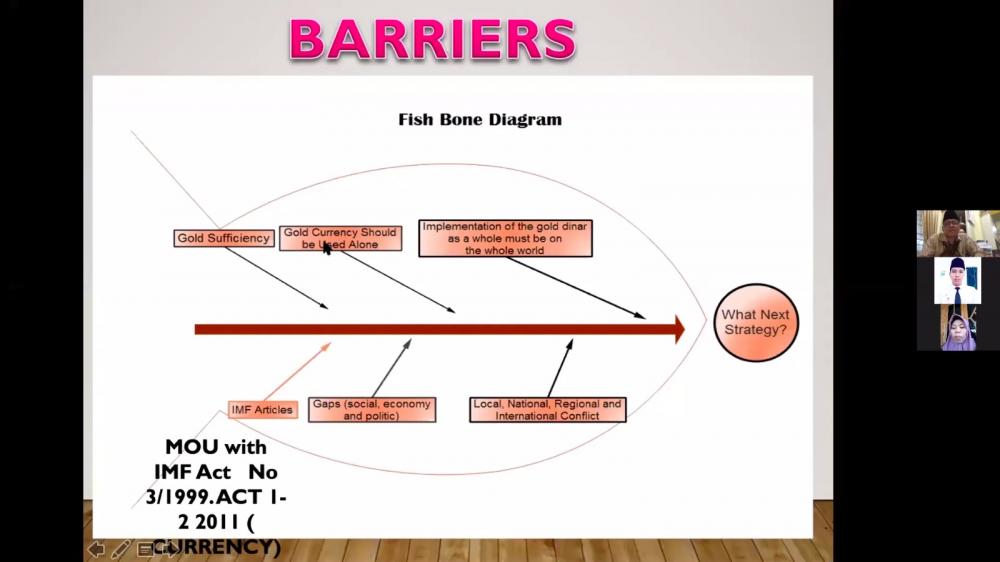Fiat Money and Financial System Stability: Is it Possible to Return to the Gold Standard?

The fourth installment of the Webinar Series, part of the 2nd Round organized by lecturers and students of Sharia Financial Management at UIN Sunan Kalijaga, took place on Friday, April 17, 2020, from 09:30 AM to 11:00 AM. The moderator for Webinar Series #4 was Ms. Muhfiatun, S.E.I., M.E.I., a lecturer in the Sharia Financial Management Program at UIN Sunan Kalijaga. The guest speaker for this webinar was Drs. Bedjo Santoso, MT, Ph.D., Vice Rector 1 of the Islamic University of Sultan Agung Semarang.
The theme of this webinar was 'Fiat Money and Financial System Stability: Is it Possible to Return to the Gold Standard?'. The moderator began by mentioning a High-Level Conference (KTT) held in Kuala Lumpur, Malaysia, in 2019, where one of the topics discussed was creating global financial stability. To achieve this, Datuk Mahatir Muhammad suggested the return to using gold dinars as currency for Muslim countries. Notably, China also surprised the world by introducing digital currency backed by gold in response to the Covid-19 pandemic, reducing speculation opportunities. Fiat money was criticized for causing global financial instability, as observed in Indonesia due to the weakness of the Indonesian currency against the US dollar.
During the webinar, the speaker delved into the history of gold-backed currency, which dominated the world monetary system for centuries. Gold currencies were in use long before the Common Era, from the Bimetallic System in 1923 to the Bretton Woods System in 1971. However, since 1971, fiat money has been the primary form of currency for the past 50 years. The speaker highlighted that during the 13 centuries of gold-backed systems, only one crisis occurred, during the Mamluk dynasty. In contrast, fiat money has experienced eight economic crises and seven global crises in the 50 years of its usage.
The problems associated with fiat money were attributed to speculative activities. Fiat money could lead to wealth erosion due to inflation. The speaker illustrated this by stating that in 40 years, the purchasing power of the Indonesian Rupiah had decreased by 8% annually, and the US Dollar had decreased by 5% annually over the same period. Indonesia experienced 78% inflation in 1998. If inflation remained at 7.5% annually, the cost of living in Rupiah would double in the next 10 years.
The second aspect discussed was fractional reserve banking. The fractional reserve system is criticized for allowing banks to profit easily by multiplying the money supply. The speaker presented an example where a bank, through fractional reserve banking, could potentially turn an initial deposit of Rp100,000,000 into Rp1 billion by circulating the money through the banking system.
The third point concerned interest and default. The speaker referred to mathematical models, specifically Mera's model, which demonstrated that interest or usury tended to lead to business failure or default.
Returning to the gold standard was presented as a viable solution. Gold-backed currency offers stability, rarity, homogeneity, and storability. However, challenges include the need for sufficient gold, a single unified system, social, economic, and political gaps, and a significant barrier – the IMF article prohibiting central banks from using the gold standard.
As an alternative solution, the speaker proposed leveraging economic instruments like zakat (charitable giving) and wakaf (endowments). Zakat and wakaf were emphasized for their vast potential in strengthening the real sector. The implementation of a return to the gold standard was suggested to be gradual, community-based, and in combination with digital models. The speaker acknowledged the difficulty of this transition, emphasizing that it was not an individual or community task but a national responsibility.
In conclusion, the webinar provided insights into the strengths and weaknesses of fiat money, fractional reserve banking, and interest-based systems. The potential return to a gold-backed standard was explored, with a call for a strategic, community-led approach to address challenges and create a more stable financial system.
Authors: Amy Astriana, Aulia Nurul Safitri
